An Exploration of the Pepper Robot’s Capabilities: Unveiling Its Potential
Abstract
:Featured Application
Abstract
1. Introduction
2. Related Works
3. Methodology
3.1. Mapping and Navigation
3.2. Speech Capability of Pepper
3.3. Hearing Capabilities of Pepper
3.4. Pattern Recognition
3.5. Face Detection by Pepper
4. Results and Discussions
4.1. Map and Navigation Functionality of Pepper
4.2. Speech Capability of Pepper
4.3. Hearing Capabilities of Pepper
4.4. Recognition of Patterns by Pepper
4.5. Face Detection by Pepper
5. Conclusions
Author Contributions
Funding
Institutional Review Board Statement
Informed Consent Statement
Data Availability Statement
Conflicts of Interest
Appendix A. Dialogue establishment between human and Pepper

Appendix B. Code Snippet for the Hearing Capability of Pepper
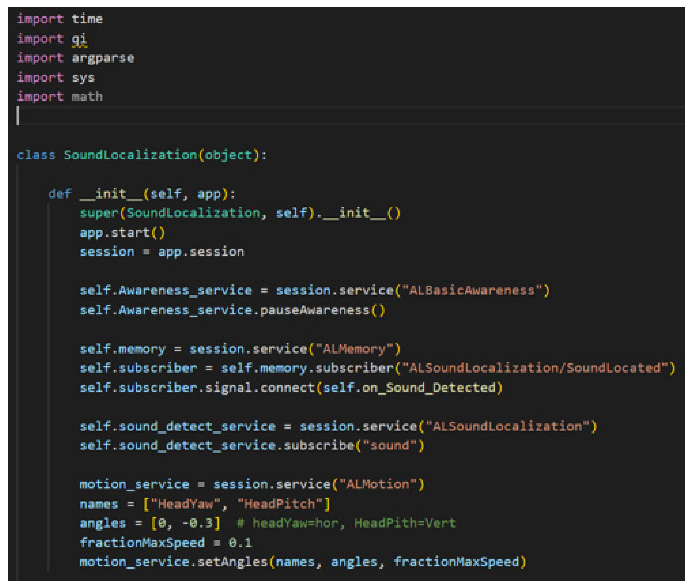
Appendix C. Code Snippet of Conversation between Human and Pepper

References
- Morris, K.J.; Samonin, V.; Baltes, J.; Anderson, J.; Lau, M.C. A robust interactive entertainment robot for robot magic performances. Appl. Intell. 2019, 49, 3834–3844. [Google Scholar] [CrossRef]
- Anzalone, S.M.; Boucenna, S.; Ivaldi, S.; Chetouani, M. Evaluating the Engagement with Social Robots. Int. J. Soc. Robot. 2015, 7, 465–478. [Google Scholar] [CrossRef]
- Yan, H.; Ang, M.H.; Poo, A.N. A Survey on Perception Methods for Human–Robot Interaction in Social Robots. Int. J. Soc. Robot. 2013, 6, 85–119. [Google Scholar] [CrossRef]
- Dağlarlı, E.; Dağlarlı, S.F.; Günel, G.; Köse, H. Improving human-robot interaction based on joint attention. Appl. Intell. 2017, 47, 62–82. [Google Scholar] [CrossRef]
- Breazeal, C.; Dautenhahn, K.; Kanda, T. Social Robotics. In Springer Handbook of Robotics; Siciliano, B., Khatib, O., Eds.; Springer International Publishing: Cham, Switzerland, 2016; pp. 1935–1972. [Google Scholar]
- Alotaibi, S.B.; Manimurugan, S. Humanoid robotic system for social interaction using deep imitation learning in a smart city environment. Front. Sustain. Cities 2022, 4, 1076101. [Google Scholar] [CrossRef]
- Pandey, A.K.; Gelin, R. A Mass-Produced Sociable Humanoid Robot: Pepper: The First Machine of Its Kind. IEEE Robot. Autom. Mag. 2018, 25, 40–48. [Google Scholar] [CrossRef]
- Draghici, B.G.; Dobre, A.E.; Misaros, M.; Stan, O.P. Development of a Human Service Robot Application Using Pepper Robot as a Museum Guide. In Proceedings of the 2022 IEEE International Conference on Automation, Quality and Testing, Robotics (AQTR), Cluj-Napoca, Romania, 10–21 May 2022. [Google Scholar]
- Miyagawa, M.; Yasuhara, Y.; Tanioka, T.; Locsin, R.; Kongsuwan, W.; Catangui, E.; Matsumoto, K. The optimization of humanoid robot’s dialog in improving communication between humanoid robot and older adults. Intell. Control Autom. 2019, 10, 118–127. [Google Scholar] [CrossRef]
- Suddrey, G.; Jacobson, A.; Ward, B. Enabling a pepper robot to provide automated and interactive tours of a robotics laboratory. arXiv 2018, arXiv:1804.03288. [Google Scholar]
- Karar, A.; Said, S.; Beyrouthy, T. Pepper humanoid robot as a service robot: A customer approach. In Proceedings of the 2019 3rd International Conference on Bio-Engineering for Smart Technologies (BioSMART), Paris, France, 24–26 April 2019. [Google Scholar]
- Woo, H.; LeTendre, G.K.; Pham-Shouse, T.; Xiong, Y. The use of social robots in classrooms: A review of field-based studies. Educ. Res. Rev. 2021, 33, 100388. [Google Scholar] [CrossRef]
- Mishra, D.; Parish, K.; Lugo, R.G.; Wang, H. A framework for using humanoid robots in the school learning environment. Electronics 2021, 10, 756. [Google Scholar] [CrossRef]
- Ghita, A.S.; Gavril, A.F.; Nan, M.; Hoteit, B.; Awada, I.A.; Sorici, A.; Mocanu, I.G.; Florea, A.M. The AMIRO Social Robotics Framework: Deployment and Evaluation on the Pepper Robot. Sensors 2020, 20, 7271. [Google Scholar] [CrossRef]
- Gardecki, A.; Podpora, M. Experience from the operation of the Pepper humanoid robots. In Proceedings of the 2017 Progress in Applied Electrical Engineering (PAEE), Koscielisko, Poland, 25–30 June 2017. [Google Scholar]
- Carros, F.; Meurer, J.; Löffler, D.; Unbehaun, D.; Matthies, S.; Koch, I.; Wieching, R.; Randall, D.; Hassenzahl, M.; Wulf, V. Exploring human-robot interaction with the elderly: Results from a ten-week case study in a care home. In Proceedings of the 2020 CHI Conference on Human Factors in Computing Systems, Honolulu, HI, USA, 25–30 April 2020. [Google Scholar]
- Ekström, S.; Pareto, L. The dual role of humanoid robots in education: As didactic tools and social actors. Educ. Inf. Technol. 2022, 27, 12609–12644. [Google Scholar] [CrossRef]
- Marku, D. Child-Robot Interaction in Language Acquisition Through Pepper Humanoid Robot; NTNU: Gjøvik, Norway, 2022. [Google Scholar]
- Pande, A.; Mishra, D. The Synergy between a Humanoid Robot and Whisper: Bridging a Gap in Education. Electronics 2023, 12, 3995. [Google Scholar] [CrossRef]
- Alhmiedat, T.; Marei, A.M.; Messoudi, W.; Albelwi, S.; Bushnag, A.; Bassfar, Z.; Alnajjar, F.; Elfaki, A.O. A SLAM-based localization and navigation system for social robots: The pepper robot case. Machines 2023, 11, 158. [Google Scholar] [CrossRef]
- Gómez, C.; Mattamala, M.; Resink, T.; Ruiz-Del-Solar, J. Visual slam-based localization and navigation for service robots: The pepper case. In RoboCup 2018: Robot World Cup XXII 22; Springer: Berlin/Heidelberg, Germany, 2018. [Google Scholar]
- Silva, J.R.; Simão, M.; Mendes, N.; Neto, P. Navigation and obstacle avoidance: A case study using Pepper robot. In Proceedings of the IECON 2019-45th Annual Conference of the IEEE Industrial Electronics Society, Lisbon, Portugal, 14–17 October 2019. [Google Scholar]
- Ardón, P.; Kushibar, K.; Peng, S. A hybrid SLAM and object recognition system for pepper robot. arXiv 2019, arXiv:1903.00675. [Google Scholar]
- Naoqi API Documentation—Vision. Softbank Robotics. 2018. Available online: http://doc.aldebaran.com/2-5/naoqi/vision/allandmarkdetection.html (accessed on 30 April 2023).
- Gardecki, A.; Podpora, M.; Beniak, R.; Klin, B. The Pepper Humanoid Robot in Front Desk Application. In Proceedings of the 2018 Progress in Applied Electrical Engineering (PAEE), Koscielisko, Poland, 18–22 June 2018. [Google Scholar]
- Greco, A.; Roberto, A.; Saggese, A.; Vento, M.; Vigilante, V. Emotion Analysis from Faces for Social Robotics. In Proceedings of the 2019 IEEE International Conference on Systems, Man and Cybernetics (Smc), Bari, Italy, 6–9 October 2019; pp. 358–364. [Google Scholar]
- Reyes, E.; Gómez, C.; Norambuena, E.; Ruiz-del-Solar, J. Near Real-Time Object Recognition for Pepper Based on Deep Neural Networks Running on a Backpack. In RoboCup 2018: Robot World Cup XXII; Springer International Publishing: Cham, Switzerland, 2019. [Google Scholar]
- Subedi, A.; Pandey, D.; Mishra, D. Programming Nao as an Educational Agent: A Comparison Between Choregraphe and Python SDK. In Innovations in Smart Cities Applications Volume 5, Proceedings of the 6th International Conference on Smart City Applications, Safranbolu, Turkey, 27–29 November 2021; Springer: Berlin/Heidelberg, Germany, 2021. [Google Scholar]
- Naoqi API Documentation. Softbank Robotics. 2018. Available online: http://doc.aldebaran.com/2-5/naoqi/index.html (accessed on 30 April 2023).
- Choregraphe Suite. Softbank Robotics. 2018. Available online: http://doc.aldebaran.com/2-5/software/choregraphe/index.html (accessed on 30 April 2023).
- Lafaye, J.; Gouaillier, D.; Wieber, P.-B. Linear model predictive control of the locomotion of Pepper, a humanoid robot with omnidirectional wheels. In Proceedings of the 2014 IEEE-RAS International Conference on Humanoid Robots, Madrid, Spain, 18–20 November 2014. [Google Scholar]
- Bauer, Z.; Escalona, F.; Cruz, E.; Cazorla, M.; Gomez-Donoso, F. Refining the fusion of pepper robot and estimated depth maps method for improved 3d perception. IEEE Access 2019, 7, 185076–185085. [Google Scholar] [CrossRef]
- Bauer, Z.; Escalona, F.; Cruz, E.; Cazorla, M.; Gomez-Donoso, F. Improving the 3D perception of the pepper robot using depth prediction from monocular frames. In Advances in Physical Agents: Proceedings of the 19th International Workshop of Physical Agents (WAF 2018), Madrid, Spain, 22–23 November 2018; Springer: Berlin/Heidelberg, Germany; p. 2018.
- Perera, V.; Pereira, T.; Connell, J.; Veloso, M. Setting up pepper for autonomous navigation and personalized interaction with users. arXiv 2017, arXiv:1704.04797. [Google Scholar]
- Stommel, W.; de Rijk, L.; Boumans, R. “Pepper, what do you mean?” Miscommunication and repair in robot-led survey interaction. In Proceedings of the 2022 31st IEEE International Conference on Robot and Human Interactive Communication (RO-MAN), Napoli, Italy, 29 August–2 September 2022. [Google Scholar]
- Oudah, M.; Al-Naji, A.; Chahl, J. Hand Gesture Recognition Based on Computer Vision: A Review of Techniques. J. Imaging 2020, 6, 73. [Google Scholar] [CrossRef] [PubMed]
- Pepper, R. Facial Recognition (Part of the Pepper Series). 2019. Available online: https://blogemtech.medium.com/pepper-facial-recognition-43e24b10cea2 (accessed on 30 April 2023).
- Caniot, M.; Bonnet, V.; Busy, M.; Labaye, T.; Besombes, M.; Courtois, S.; Lagrue, E. Adapted Pepper. arXiv 2020, arXiv:2009.03648. [Google Scholar]
- Tariq, S.; Jeon, S.; Woo, S.S. Evaluating Trustworthiness and Racial Bias in Face Recognition APIs Using Deepfakes. Computer 2023, 56, 51–61. [Google Scholar] [CrossRef]
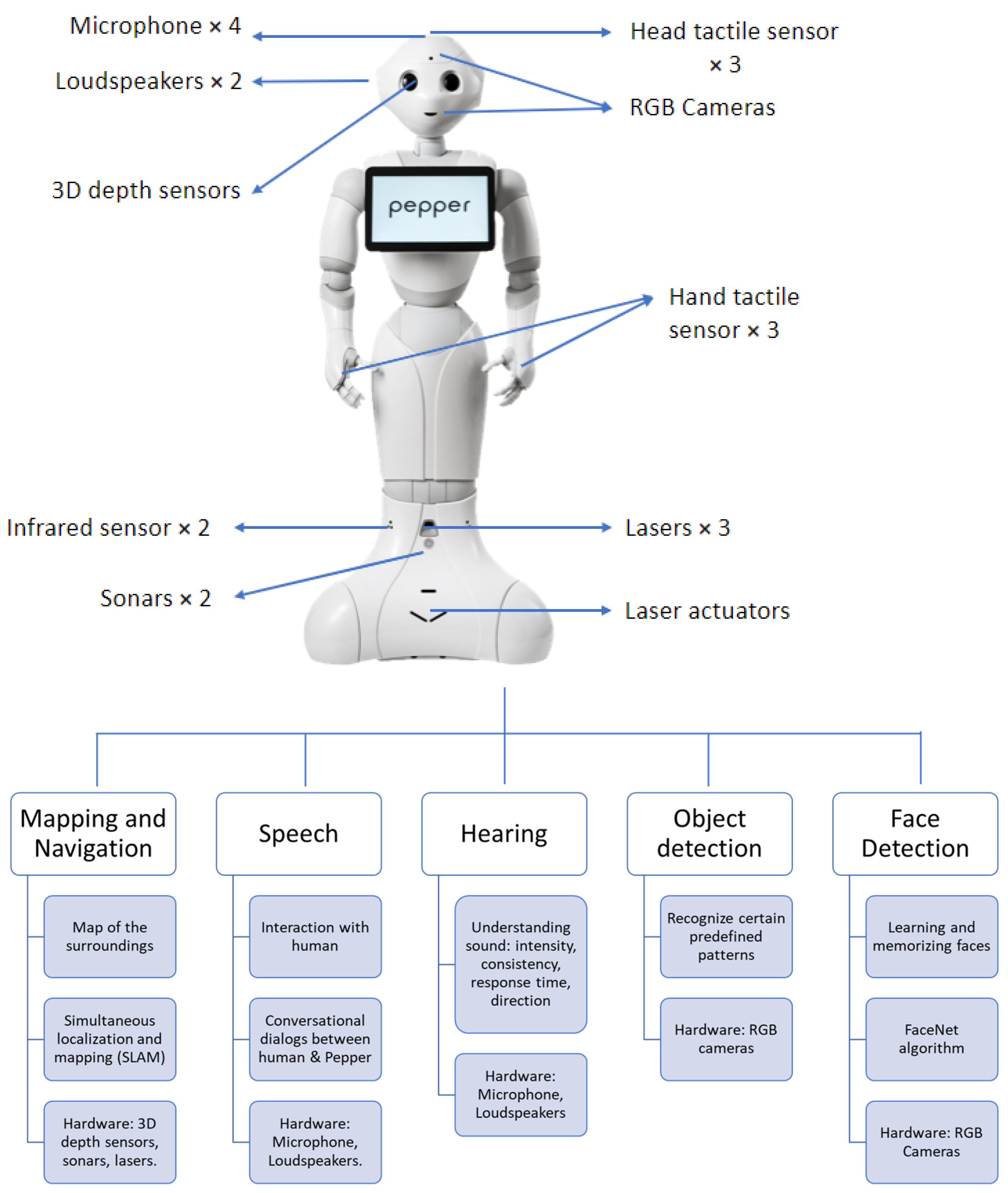
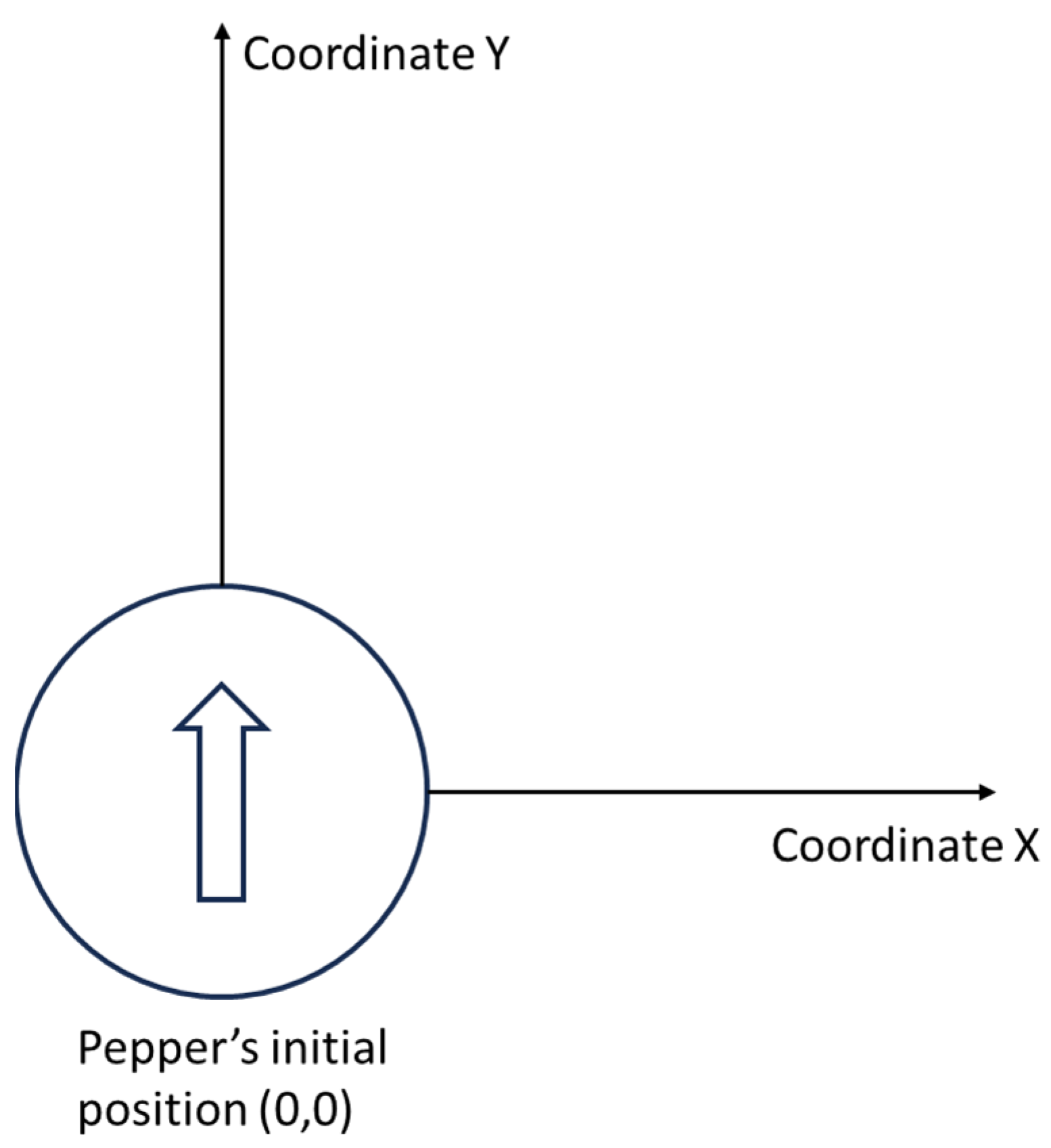

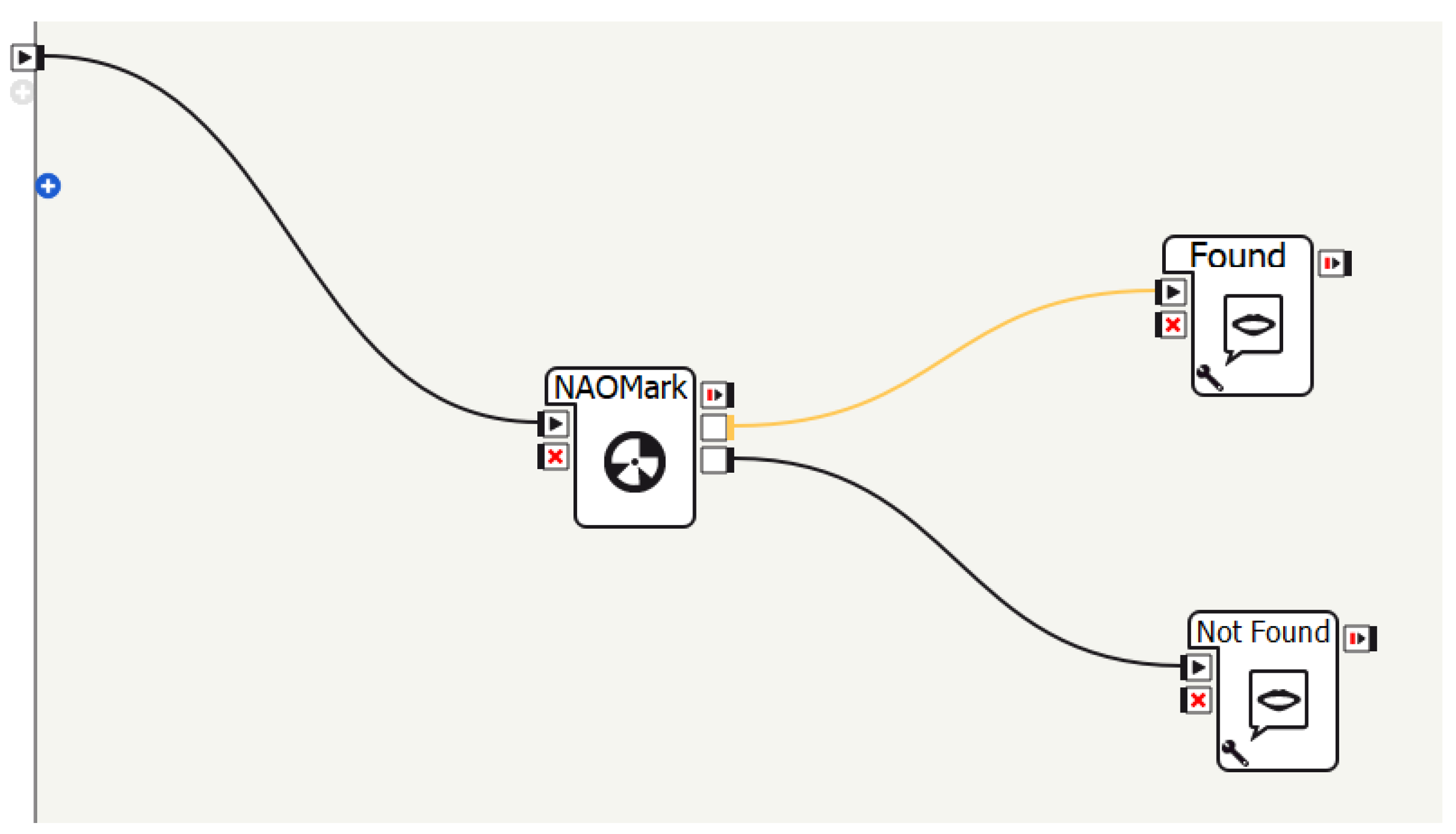

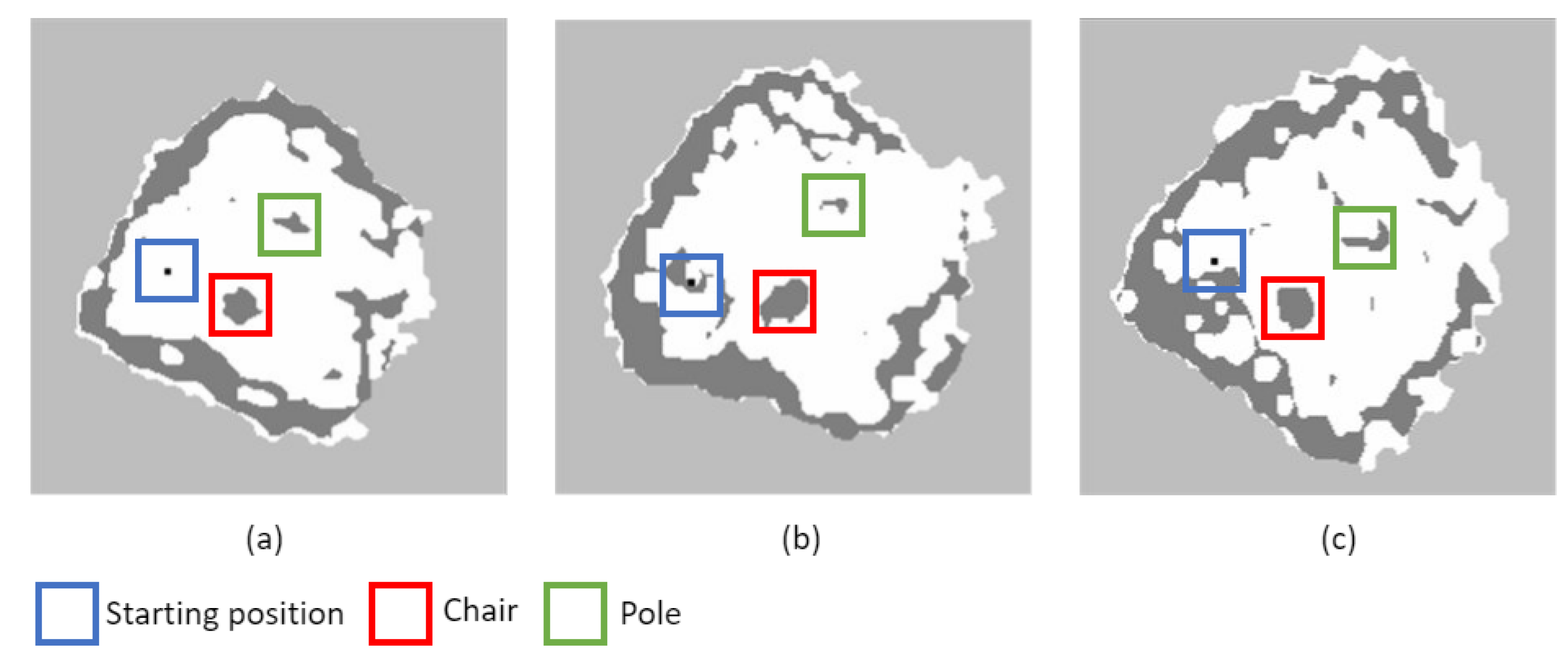

| Functionality | Services Used | Purpose of the Service Used |
|---|---|---|
| Mapping and Navigation | ALNavigation module—API Exploration and API Navigation | Exploration API [29] is used for Pepper’s odometry and lasers to perform SLAM. Navigation API allows Pepper to self-locate and move in safe trajectories based on an obstacles map of the near environment. |
| Speech | ALDialog, ALMotion, ALRobotPosture | ALDialog service [29] is used to explore Pepper’s speech capabilities and conversational skills, using a list of written and categorized rules. ALMotion service [29] controls the gesture and posture of Pepper. ALRobotPosture [29] traces the posture of pepper. |
| Hearing | ALBasicAwareness, ALMemory, ALMotion, ALSoundLocalization | Basic awareness enables the robot to know the stimuli from its surrounding environment. ALMemory and ALSoundLocalization [29] are used to subscribe to the events of sound located and sound. |
| Object Detection | Choreographe and ALLandMarkDetection vision module | ALLandMarkDetection [24] is a vision module in which the robot recognizes special landmarks with specific patterns called NAOMarks. Choreographe [30] is a GUI platform for working with Pepper. |
| Face Detection | Choreographe and LearnFace module | LearnFace: Integrated command of Choreographe with which Pepper saves a user’s face into its memory. |
| Testing Response of Pepper | Purpose of the Experiment | Questions | Number of Times the Experiment Was Repeated | Observation |
|---|---|---|---|---|
| Multiple inputs | When Pepper confronts multiple inputs at the same time | Q1. ‘What is your name?’ Q2. ‘How are you?’ | 5 | Pepper showed no response, and the request was not resolved. |
| Distance | To analyze how good Pepper was at noting the inputs | Questions asked to Pepper standing at different distances until 5 m | 2 | Each time, Pepper responded with a good, acceptable rate of response in the above experiment. |
| Consistency | To measure the consistency of pepper | Q1. ‘How are you?’ Q2. ‘Am good’ | 4 | R1. ‘Am always doing good… How are you?’ R2. ‘So, we both are doing good.’ |
| Accent | To check whether Pepper can understand different accents | Users with different accents asked Pepper the same question | 4 | Most of the time, the response time of Pepper was good, which was less than a second. |
| Testing Pepper for | Experiment Details | Number of Times the Experiment Repeated | Pepper’s Response |
|---|---|---|---|
| Multiple inputs | Three observers clapped at the same time with differentiable levels of sound—low, medium, and loud | 5 | Pepper responded to the loudest sound every time and moved toward it. |
| Distance | To analyze Pepper’s response to sound from a distance, standing at different distances up to 5 m, we tried clapping | 4 | Every time Pepper responded correctly |
| Consistency in response | To measure how consistent Pepper is in recognizing the sound | 10 | Pepper was consistent all the time |
| Response time | To measure how quickly Pepper responds using a clap experiment | 10 | Pepper’s response was under 1 s |
| Elevation detection of sound | To measure the hearing capabilities of Pepper at different orientations | 5 | There was no difference in the detection of elevation when the sound source was greater than 4 m |
| Distance (in Meter) | Diameter of NAOMarks (in cm) | Recognition |
|---|---|---|
| 0.1 | 5.5 | No |
| 1 | 5.5 | Yes |
| 2 | 5.5 | No |
| 3 | 5.5 | No |
| 4 | 5.5 | No |
| 0.1 | 9 | No |
| 1 | 9 | Yes |
| 2 | 9 | Yes |
| 3 | 9 | Yes |
| 4 | 9 | No |
| Distance | Accessory | EYE Contact | EYE Contact | EYE Contact | NO EYE Contact | NO EYE Contact | NOEYE Contact |
|---|---|---|---|---|---|---|---|
| Direct | 25° | 45° | 25° | 45° | 90° | ||
| <1 m | None | 100% | 83% | 100% * | 16% | 33% | 0%/NF |
| <1 m | Bini | 81% * | 87% * | 68%/NF | 66% | NF | NF |
| <1 m | Scarf/UN | 76% | 77% * | 41%/NF | 66% * | 33% */NF | NF |
| <1 m | Scarf/ON | NF | NF | NF | NF | NF | NF |
| <1 m | Glasses | 44% * | 4% */NF | 16% | 11% | NF | NF |
| 1.70 m | None | 100% | 66% | 33% | 53% | 0% | NF |
| 1.70 m | Bini | 66% | 50% | 87% | 87% * | NF | NF |
| 1.70 m | Scarf/UN | 0%/NF | 12%/NF | 50%/NF | 0%/NF | NF | NF |
| 1.70 m | Scarf/ON | 0% */NF | 0% */NF | NF | NF | NF | NF |
| 1.70 m | Glasses | 50% */NF | 0%/NF | 0%/NF | 0%/NF | 50%/NF | NF |
Disclaimer/Publisher’s Note: The statements, opinions and data contained in all publications are solely those of the individual author(s) and contributor(s) and not of MDPI and/or the editor(s). MDPI and/or the editor(s) disclaim responsibility for any injury to people or property resulting from any ideas, methods, instructions or products referred to in the content. |
© 2023 by the authors. Licensee MDPI, Basel, Switzerland. This article is an open access article distributed under the terms and conditions of the Creative Commons Attribution (CC BY) license (https://creativecommons.org/licenses/by/4.0/).
Share and Cite
Mishra, D.; Romero, G.A.; Pande, A.; Nachenahalli Bhuthegowda, B.; Chaskopoulos, D.; Shrestha, B. An Exploration of the Pepper Robot’s Capabilities: Unveiling Its Potential. Appl. Sci. 2024, 14, 110. https://doi.org/10.3390/app14010110
Mishra D, Romero GA, Pande A, Nachenahalli Bhuthegowda B, Chaskopoulos D, Shrestha B. An Exploration of the Pepper Robot’s Capabilities: Unveiling Its Potential. Applied Sciences. 2024; 14(1):110. https://doi.org/10.3390/app14010110
Chicago/Turabian StyleMishra, Deepti, Guillermo Arroyo Romero, Akshara Pande, Bhavana Nachenahalli Bhuthegowda, Dimitrios Chaskopoulos, and Bhanu Shrestha. 2024. "An Exploration of the Pepper Robot’s Capabilities: Unveiling Its Potential" Applied Sciences 14, no. 1: 110. https://doi.org/10.3390/app14010110
APA StyleMishra, D., Romero, G. A., Pande, A., Nachenahalli Bhuthegowda, B., Chaskopoulos, D., & Shrestha, B. (2024). An Exploration of the Pepper Robot’s Capabilities: Unveiling Its Potential. Applied Sciences, 14(1), 110. https://doi.org/10.3390/app14010110







